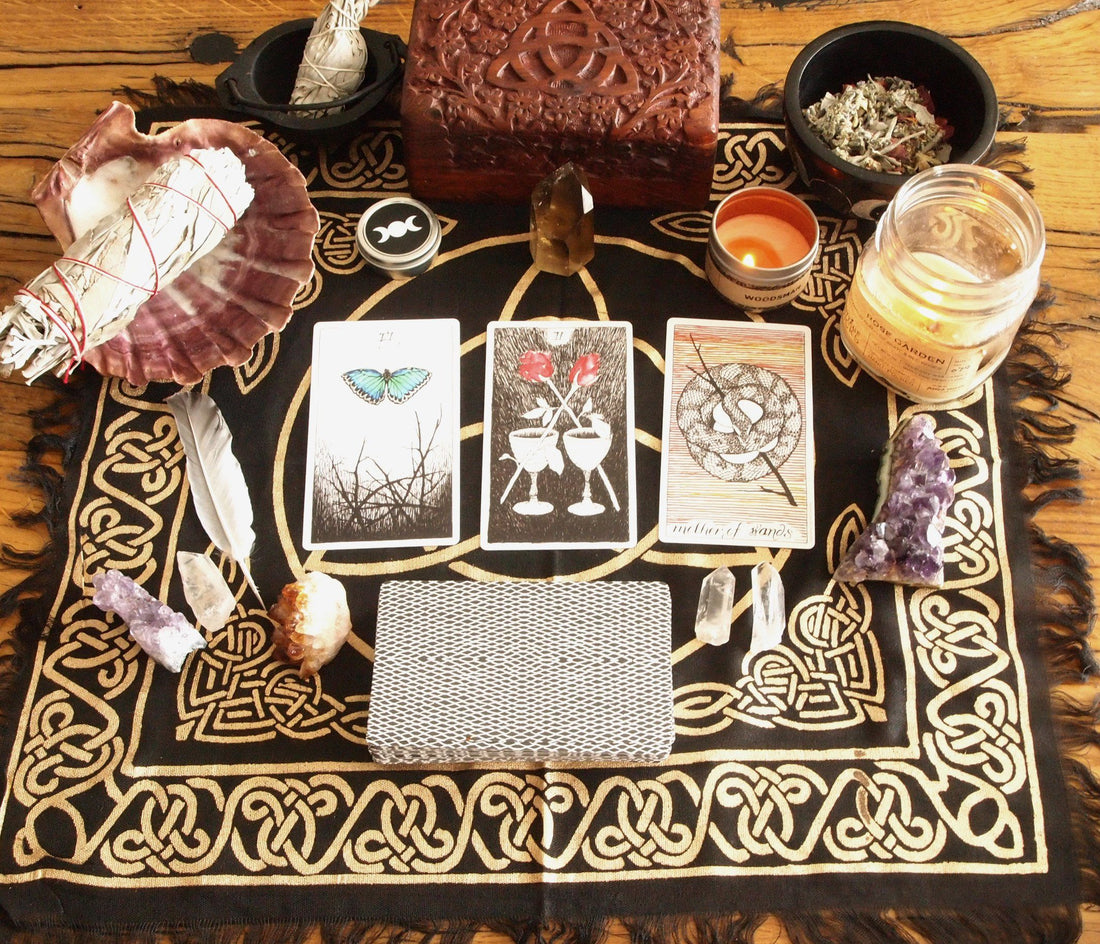Altars are used worldwide by people of many different religions and traditions. They are found in temples, churches, natural places, and historical sites. They can also be found in homes and are becoming a popular way of growing one’s spirituality. Altars act as liminal space where the physical breaches the spiritual; where we can readily meet with Source Energy, the gods, our higher selves, angels, guides, and ancestors. By setting up an altar in your home, you are establishing sacred space – a safe, comfortable place to focus on your spiritual growth without anyone else telling you how to practice. No matter your religion or spiritual path, an altar provides a central location within your home for meditation, quiet contemplation, spell-working, ritual, prayer, divination, yoga, and more.
How to Set Up An Altar
Setting up an altar is not as complicated as it may sound. First, you’ll need to decide what piece of furniture you will use as your altar. Corner tables, end tables, and cabinets are a popular choice, but some choose a small wall shelf or even a corner of a kitchen counter or nightstand. It all depends on how much space you have in your home, the people with whom you share your home, and your personal preferences. A popular question asked is which direction the altar should face – north, south, east, or west? This really depends on your religious affiliation or spiritual path. In some of the Wiccan traditions, altars are suggested to face North, the direction of the element of earth. In some eastern religions, altars face east towards the rising sun. And still there are those who believe the direction of the altar doesn’t matter. The choice is ultimately up to you and your beliefs, as there is no right or wrong way.
Once you’ve decided what you are using as an altar, then you’ll decide what tools and sacred talismans to include on your altar. This is the fun part! Often these sacred items are related to nature and the elements. Some may choose a tool to represent each of the four elements, such as: a cauldron for earth, incense for air, candles for fire, an abalone shell for water. These are just a few examples. Other sacred items for your altar may include crystals, plants, statues, tarot cards, flowers, shells, books, and the list goes on. Keep in mind that candles are almost always a must, particularly if you’re doing any spiritual work at night. Candlelight creates an ambiance you will not achieve with false fluorescent lights or lamps. Incense is also helpful to set the mood, whether you are meditating, praying, or casting a spell. Incense is also used as an offering to deities and ancestors. Add an altar cloth to protect the altar-top plus bring in a certain energy to your space. A tapestry can be hung behind your altar to honor your deities or ancestors. There is no limit to what sacred tools and items you include on your altar. It is your sacred space, after all.
Now you have your altar and all your sacred tools ready. Don’t forget one of the most crucial steps in establishing your sacred space – cleansing and consecrating. It is important to cleanse your altar and your tools, because when you bring items into your home from other places, they can carry energies that you might not want in your sacred space. To cleanse your altar and tools, it is wise to use a sage bundle and perform a small smudging ritual.
How to Cleanse Your Sacred Space
You will need the following:
- Sage bundle
- Abalone shell or fireproof bowl (to catch ashes)
- A candle
- Matches
- Feather (optional)
How to smudge your altar and tools:
- First, light one of the candles on your altar. Take a couple of deep breaths. If you believe in prayer, now is a good time to pray and ask for God’s/the Universe’s/deity’s love to fill your space and help guide your movements.
- Use your dominant hand to hold one end of the sage bundle over the candle’s flame to light it. It will start smoking and you will see slight red embers at the end of the sage bundle.
- Hold your abalone shell or clay fireproof bowl with your non-dominant hand and underneath of the sage to catch any falling ashes as the sage burns.
- Say out loud, “with this sage smoke, I cleanse my space and tools of all negative energy so that they may be used for my highest good.”
- Using the smoke from the sage bundle, gently blow the smoke over your altar and sacred tools. As you do this, visualize the smoke cleansing away any negative energy. (NOTE: Some people prefer to leave the sage bundle in the shell/bowl while fanning the smoke with a feather, but the choice is up to you.)
- Once you’ve cleansed your entire altar and tools with the sage smoke, you may smother the burning sage in the abalone shell or put it out in a bowl of salt.

Smudge stick Abalone smudge shell Bewitching incense
Now that you’ve cleansed your space and tools, the last step is to perform a simple consecration (also called a blessing). This can be done by stating out loud, “I consecrate (bless) this altar and sacred space in the name of _______ (insert your god/ancestor/Universe/Source here). It is now cleansed of negative energy. May it be a place of spiritual growth and may it be for my highest good. So be it.”
Written by The Otherworldly Oracle , follow her site and FB group
as it is the best online sources for information and tips on the mystic, pagan, and supernatural enthusiast.





14 comments
Veronica, im not sure if i have Native American ancestors or not, in the mean time what would you suggest i use instead? :) I want to respect cultures but I also want to make sure my space is cleansed correctly.
Please do not use white sage unless you have Native American ancestry and know its significance in rituals. It’s a sacred plant and should be respected accordingly.
I was wondering if I should leave the representatives of each element in certain corners, and if so which ones? I don’t have my alter pointed in a particular direction either. Would I just go by where a compass would be if I was pointed in a certain direction?
Abigail, you can use a cleansing spray to help with cleansing your alter if you can’t burn with sage. There is a pot of wonderful people on YouTube who can help with how to make those. Blessed be
I’m new to this whole thing and this was very helpful, but I would like to know if there are other ways to cleanse a space for the altar.